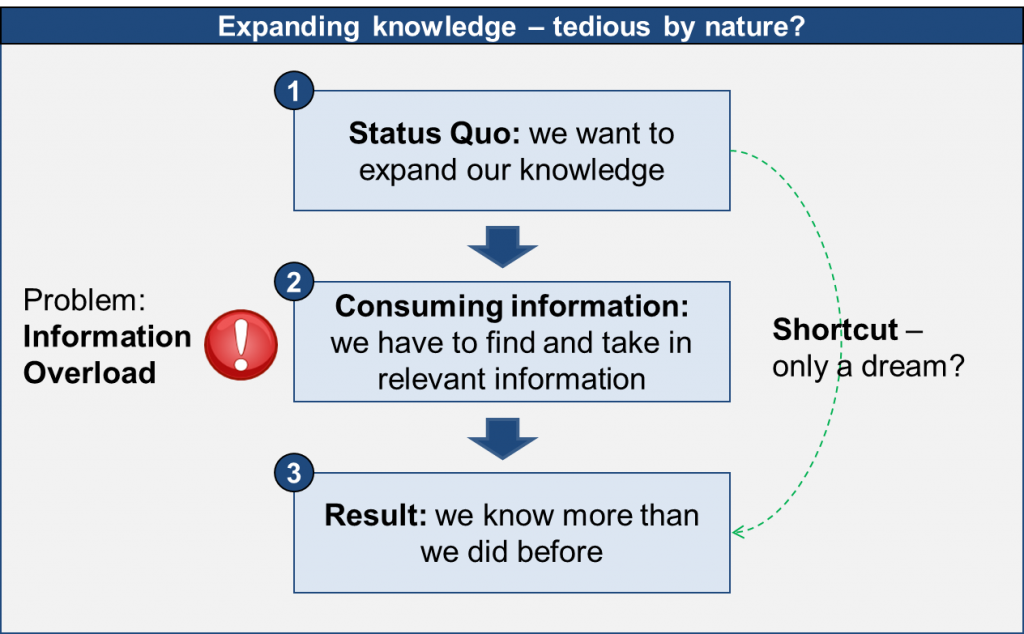-
The Power of Reliable Alert Services: Getting Smarter Without Doing Anything?
by SebDec 4, 20121 CommentPlease answer the question before reading on:
Is it possible to accumulate information and “get smarter” effortlessly
without spending time to research or consume it?At first it seems to be an unbreakable rule that in order to expand our knowledge, we need to actively take in new information. Unfortunately, finding relevant information and consuming it takes time and effort – especially in today’s world of information overload this can be quite tedious.
Wouldn’t it be fantastic if we did not have to consume any information and still expand our knowledge as shown in the following picture, therefore sidestepping information overload?
Surprisingly, there is a way to achieve this. The secret lies in reliable alert services that only inform you if a specific event has occurred, therefore also telling you something if no message is sent (so that you know nothing has happened).
For example, imagine an alert service which notifies you every time a US tennis player wins a tournament on the ATP tour. If you haven’t received an alert for the last two months and somebody asks you about it, you could tell that in the last 2 months no US player has won a tournament – without actively following the tennis results.
-
The Pomodoro Technique – A Cool Way To Stay Focused And Increase Productivity
by SebNov 17, 2012Subject of this post is the Pomodoro Technique which I came across about a year ago. Since then it has helped me a lot to stay focused and get more tasks completed (this article being one of the outcomes, took me 3 pomodoros). Why don’t you try it too?
The concept behind the Pomodoro Technique was developed by Francesco Cirillo during his university days in the 1980's. Faced with a crippling productivity slump after his exams, he began to take a long hard look at his work habits and tried to figure out what was wrong. He came to the conclusion that the real issue was that it’s getting harder to fully focus intensively on a task, even if it is just for a short period of time.
And that's how the Pomodoro Technique was born. Armed with a tomato-shaped timer (“Pomodoro” means tomato in Italian), Cirillo set off to create one of the most simple yet innovative productivity methods that has helped thousands (millions?) of people around the globe manage their time better.
In a Nutshell: The Pomodoro Technique
Here's how it works; first off, you need a timer (any timer will do, though most followers stay true to the concept and get themselves those tomato-shaped kitchen timers), a pen or pencil, and a notebook where you can record your progress.
A Pomodoro consists of 25 minutes of intense concentration on a single task, followed by a 5-minute break. After four Pomodoros have elapsed, you can then take a longer break (a fifteen or thirty minute interval works fine) and then the whole cycle can be repeated again.
A typical Pomodoro cycle looks like this:
- Tasks to be accomplished for the day are listed down. You can use this To Do Today sheet provided by Pomodoro Technique website. It includes an area for pending tasks and a section labeled "Unplanned and Urgent Activities" where unexpected yet necessary tasks that pop up during the day are filed.
- The timer is set for 25 minutes and the tasks are worked on one by one. The breaks (both short and long ones) are to be used for activities that are NOT related to work. Once a Pomodoro is used up, a corresponding mark should be written down on your recording sheet or notebook. You can rest, eat, stretch or do any other activity that can help to refresh your mind.
- At the end of the day, observations regarding your performance need to be recorded. This part usually includes recording the number of Pomodoros that were spent on each task and the number of interruptions (if any). Writing these down will often help you predict the number of Pomodoros to be assigned for future activities.
The whole process is simple enough to comprehend, but there are two key rules to be followed if the system is to be used to its maximum potential.
-
Rule Number One: A Pomodoro is Indivisible
An ongoing Pomodoro cannot be disrupted. If it is to be interrupted by an urgent matter, that particular Pomodoro needs to be crossed out and voided. Upon returning to work, you need to start on a fresh Pomodoro. -
Rule Number Two: If a Pomodoro Begins, It Has to Ring
Every Pomodoro should be worked on from start to finish. If a task is finished before the timer runs out, you could use this time to review your work and make improvements, if necessary. This process is called "overlearning."






